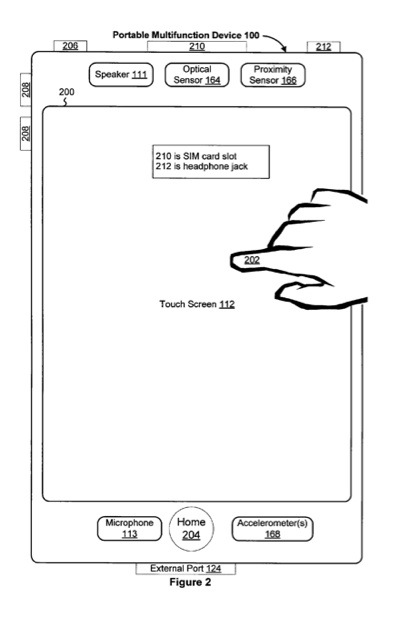Apple has been granted a patent (number 8171432) for a touch screen device, method and graphical user interface (UI) for displaying and selecting application options. embodiments relate generally to computing devices with touch screen displays, and more particularly, to selecting application options on computing devices with touch screen displays. Based on the graphics, it make you wonder if Apple is planning bigger iPads.
Per the patent, in accordance with some embodiments, a flat version of an application interface is displayed. In response to detecting a user gesture on a view options icon while the flat version of the application interface is displayed, a curled version of the application interface is displayed. The curled version of the application interface includes an image of a curled page that obscures a first portion of the flat version of the application interface, and a roll-up region in a display region formerly occupied by a second portion of the flat version of the application interface.
The roll-up region includes a plurality of option icons. When a user selection gesture on one or more of the plurality of option icons is detected, the flat version of the application interface is redisplayed with information corresponding to the option icons upon which user selection gestures were detected.
Here’s Apple’s background on the invention: “As portable electronic devices become more compact, and the number of functions performed by a given device increase, it has become a significant challenge to design a user interface that allows users to easily interact with a multifunction device. This challenge is particular significant for handheld portable devices, which have much smaller screens than desktop or laptop computers. This situation is unfortunate because the user interface is the gateway through which users receive not only content but also responses to user actions or behaviors, including user attempts to access a device’s features, tools, and functions.
“Some portable communication devices (e.g., mobile telephones, sometimes called mobile phones, cell phones, cellular telephones, and the like) have resorted to adding more pushbuttons, increasing the density of push buttons, overloading the functions of pushbuttons, or using complex menu systems to allow a user to access, store and manipulate data. These conventional user interfaces often result in complicated key sequences and menu hierarchies that must be memorized by the user.
“Many conventional user interfaces, such as those that include physical pushbuttons, are also inflexible. This is unfortunate because it may prevent a user interface from being configured and/or adapted by either an application running on the portable device or by users. When coupled with the time consuming requirement to memorize multiple key sequences and menu hierarchies, and the difficulty in activating a desired pushbutton, such inflexibility is frustrating to most users.
“For example, mapping applications are available for mobile phones (e.g., Google maps for mobile, available at www.google.com/gmm). But navigating in such applications using physical push buttons (e.g., the number keys on a hard keyboard) or touch screens in existing mobile phones is cumbersome for most users. Thus, at present, relatively few people use mapping applications in mobile phones and other computing devices with touch screen displays. Similar problems arise in selecting application options in other applications on computing devices with touch screen displays.
“Accordingly, there is a need for computing devices with touch screen displays that have more transparent and intuitive user interfaces for displaying and selecting application options. Such interfaces increase the effectiveness, efficiency and user satisfaction with such devices.”
The inventors are Michael Matas, Chris Blumenberg, Stephen O. Lemay and Richard Williamson.


